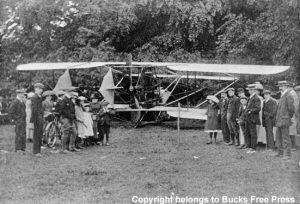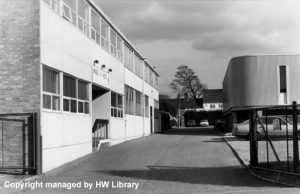A Timeline of Downley

A copper coin, found in a field near Downley in 1904, shows the bust of the Emperor Galerius and has the inscription – MAXIMIANUS NOB(illissimus) CAES(ar). The full name of this Emperor was Galerius Valerius Maximianus, who died in 311.
A History of the County of Buckingham: Vol 3 (1925) contains the following reference:
Among the Bishop of Winchester’s documents (now in the hands of the Ecclesiastical Commissioners) are rent rolls of the manor of West Wycombe, dating from the year 1207 onwards.
The manor and parish (of West Wycombe ed.) were coterminous, and from the earliest time the estate was divided for administrative purposes into ten tithings. The tithing of Bokar, still marked by Booker hamlet and common in the south of the parish, is named in the early 13th century and also in the transfer of the manor in 1706. A fourth tithing is that of Downley, still existing in the north-east of the parish.
NB Historically a tithing refers to ‘a group of ten households who lived close together and are collectively responsible for each others behaviour’.
Blacksmith’s Cottage, immediately opposite the cricket pitch, is probably the oldest house to be found in Downley today. A Grade II listed building; some accounts ascribe it to the 12th/ 13th century. Two ‘cruck’ trusses can be seen internally (a cruck or crook frame is a curved timber, one of a pair, which supports the roof of a building) and this type of construction is often found on larger houses built in the late mediaeval period (1272-1485). Thus a construction date of 13th/14th century may be more accurate. Moor Cottage, at the junction of Moor Lane and Plomer Green Lane, dates from the early 16th century.
On her return from visiting the University of Oxford, one of the many overnight stays of Queen Elizabeth I was Bradenham House, then the residence of Lord Windsor. The following day, her Majesty continued on to what is now called High Wycombe by way of Downley Common and Tinkers Wood. It is reported that she was accompanied by “a large party of gentlemen, because of thieves which infested these woods”. It should be noted that the present roads from Bradenhan and West Wycombe had not yet been constructed.
Edward Pontyfix farmed at Downley Farm and would regularly attend Wycombe market. He dressed somewhat showily, wearing a large watch on a chain and rings on his fingers,. On this occasion, in the middle of January, he walked to the Wycombe market accompanied by his 13-year-old son. Having finished his business he set off home as dusk was falling, after first visiting the Antelope public house where his wealthy appearance was noted by two strangers to the town. As Edward Pontifyx and his son entered Tinkers Wood he was attacked by the two strangers, later identified as Thomas Marsh and Richard Marshall, one of whom shot him dead. In the gathering darkness his son managed to hide and subsequently raised the alarm.
The two murderers were later caught trying to sell the watch at the very shop where it was made. This led to their arrest, and being tried for murder. They were found guilty and executed at Aylesbury. Their bodies were brought to Wycombe, and hung in chains at the east end of the Rye. The son was able to identify the murderers by the flash from the pistol shot which had lit up their faces.
Begun construction in 1797, Plomer Hill House eventually became the family home of John Hicks from Plomer Hill, Bath. It was located near the bottom of the west side of what is now Plomer Hill. On the death of John Hicks in 1821, the house was rented to various personnel including Henry Wheeler, a banker and brewer from High Wycombe. Occupied by Belgium refugees in 1915, Plomer Hill House and Estate was purchased in 1931 by Alex Stacey, a local entrepeneur, who claimed to be the owner of the first motor car in High Wycombe. The house was probably demolished in the early 1960s.
Well Cottage, built in 1813, was vital to the villagers living around the common. At over 60m deep its well never dried up, even in the most severe droughts. Cottages higher in the valley had cisterns cut in the chalk and lined with brick as water tanks.
The first religious building in Downley, the Wesleyan Chapel, was very unpretentious, being only 22 feet long by 17 feet wide, and considerably lower than at present. Mr John Wright, a local preacher of independent means, residing at Flackwell Heath, lent the money for its construction. Although small, however, it was equal to the need, as at this time Downley consisted of only thirty houses. It has been enlarged on a number of occasions and the photograph shows the structure as of 1861.
As well as being the first religious building in Downley, the Wesleyan Chapel at the end of what is now Moor Street, was the first school in the village. The certified teacher, Miss Steel, taught both boys and girls, who were each charged 3d per week, for six hours of tutelage per day. It was advertised as a means of securing a cheap and efficient education for the children resident in Downley and its vicinity.
Downley Common became the site of a nine-hole golf course, the home of the ‘Wycombe Ho Golf Club’ under the presidentship of Sir Edward Dashwood. The annual subscription for gentlemen and ladies was £1 and 10s respectively. The venture was not a commercial success and eventually the club moved to Flackwell Heath. However its memory lives on in the names Golf Links Villas, and Golf Links Cottages, which are to be be found at the far end of Plomer Green Lane. There was also a ‘Golf Links’ public house in the High Street, the site of which eventually became the present ‘Bricklayers Arms’.
Mr Alfred Smith of Reliance Nurseries succeeded in raising, after more than four years’ effort, a beautifully shaded blue rose. Given the name of ‘Lady Coventry’, the rose on opening was vermilion shaded and veined with intense blue, which predominates and extends becoming the ruling colour.
Colonel Cody was an early pioneer of manned flight and in 1908 was the first man to fly an aeroplane in Britain. In the early morning of late September he left Farnborough, planning to fly to Cambridge with his son as passenger, but experienced problems with the weather and the biplane’s compass. As a consequence he had to make an unintended landing, coming down at Mannings Field.
The Hall was built by the inhabitants of Downley on a site donated by Sir John Dashwood. Work began in April 1923 with the laying of the stone by 85-year-old Mr George Giles, a Chapel Street resident who lost two sons in the war.There followed the laying of bricks by residents and visitors with each person contributing towards the building fund.The final cost of the Hall was “in the neighbourhood of £1200” (£70-100,000 at 2020 prices).
Piped mains water cost £3 per household (equating to approximately £200 in 2018). Each household had 3 light fittings and two powerpoints installed free of charge. However extra lights cost 15s (equivalent to £50 in 2018).
By 1937 the building of houses along the triangle of Commonside, Littleworth Road and Plomer Green Lane meant that the individual hamlets of Downley, Littleworth and Plomer’s Green had merged to become Downley village. The middle cottage in the row adjacent to Hillside Garage in Littleworth Road still bears the plaque “Plomer Green cottages, 1821”.
The end of the war was a cause for festivities across the country, and Downley was no exception with an evening of celebrations on the Common. Note the design of a number of the torches – tin cans fixed to staves – still used today for the torchlight procession to the bonfire on Guy Fawkes’ night.
Downley was originally within the 1890s civil parish of West Wycombe, however, in the 1930s West Wycombe village was incorporated into the Borough of High Wycombe and the remainder of the original civil West Wycombe Parish, which included Downley, became known as West Wycombe Rural Detached Parish. As a consequence of the reorganisation of Local Government in the 1980s West Wycombe Rural Detached Parish was split into the parish of Downley Parish, and the parish of Piddington & Wheeler End.
The Mines and West Factory re-located to Princes Risborough and the site became the Mines Close and West Close housing estates.
The old Victorian Downley School took on a new lease of life when it opened as the new Downley Community Centre, growing steadily in popularity in the village. It is run by a small group of committed volunteers who meet regularly to develop and manage the facility on behalf of all local residents. The Centre is open seven days a week and is home to numerous local clubs, associations and the village community library.
The last pub to be built in Downley closed its doors and re-opened as a Morrison’s Local before finally changing ownership to a Co-Op store.
Government rules in the Spring of 2020 placed severe restrictions on the mixing of the public in general in an effort to reduce the incidence of Covid-19, by limiting social distancing to 2.0m. The Tesco Express at Cross Court introduced a one-way system in the store and 2.0m pavement markings. Staff also limited the number people in the store.












